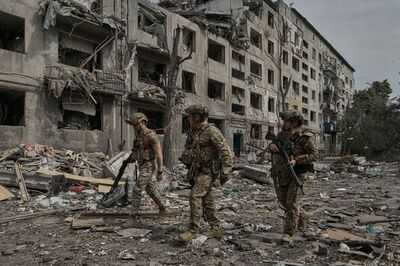Since July 2024, Russia has been hurling huge quantities of troops, vehicles, and munitions at the Ukrainian city of Pokrovsk. The 15-month offensive has cost Vladimir Putin's army tens of thousands of lives - but still it remains in Ukrainian hands.
Only just though. Earlier this week, Ukrainian President Volodymyr Zelensky admitted that Russian forces were inside the city, and reports suggest fierce house-to-house fighting in the centre. A Russian flag has even been erected on one of the main roads heading into the city.
The Ukrainians - who have taken notable losses themselves - continue to inflict significant casualties on advancing Russian troops. One Ukrainian commander in the field said it was down to one specific weapon in their arsenal that meant that Pokrovsk had held out for as long as it had: drones.
Mykola Hrytsenko is the chief of staff for the Freedom Force, part of the 4th Rubizh Brigade, which is based near Dobropillia - a city a little more than 15 miles from Pokrovsk. He is second in command of the unit, despite being just 24.
He discussed how much war had changed in the three years and eight months since Russia invaded, and how the Ukrainians were hanging on by their fingertips.
"Previously, the war resembled a big trenchline with artillery behind it and infantry in front, but it's not like that now," he told Sky News.
"The drones are incredibly important because we have limited manpower on our side. The Russians don't have that problem. They can assemble hundreds of assault groups. We can't do that. We can't sacrifice a single person."
The use of drones in the sector is astonishing. Many are still used to either drop munitions on soldiers, vehicles, and buildings, or detonate on impact with a target.
However, they have other uses. Some are equipped with loudspeakers to encourage Russian troops to surrender or herd POWs back to Ukrainian lines. Mykola uses one to guide the crew of a destroyed Ukrainian tank back to safety.
Others carry fibre-optic wires behind them that make them all but impervious to electronic warfare interference. Both sides also use quadcopters to carry heavier payloads, usually for bombing.
Unfortunately for the defenders, it appears Russia's economic superiority means they have more drones than their Ukrainian counterparts. Bender, the driver of the destroyed tank, said: "I did (feel I was being hunted by Russian drones). There were so many FPV drones.
"They were just buzzing all around us, 360 degrees... there are so many FPV drones, and you don't know where to run. I was very lucky... big luck."
But drones are not only found in the air. Freedom Force uses a ground-based drone called Termit 1. It is vital in keeping the frontline troops equipped with food and water. It is even used by Mykola's men to evacuate casualties.
A soldier named Radjik was evacuated - with difficulty - after being shot in the chest during an ambush. It took eight hours, but the soldier is alive when handed over to medical staff.
Despite their best efforts, it appears that the battle for Pokrovsk may be coming to an end. But, if Mykola's experiences are anything to go by, drones will continue to play a vital part in the fight for Ukraine's survival.
You may also like

Major UK police force increasing specialist unit to tackle knife crime crisis

Double Black Friday discount on mattress that 'makes sleep so much better'

Inside eerie and abandoned city of hotels that has been 'left to rot' for three decades

Andrea Bocelli and son Matteo Bocelli duet Fall On Me in emotional new live video

Parsnips will be golden on the outside with a sweet and fluffy interior thanks to 1 method







